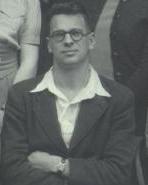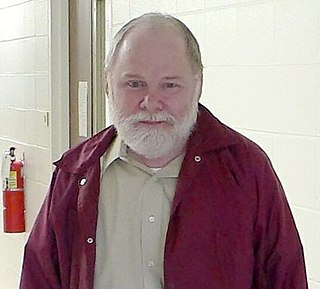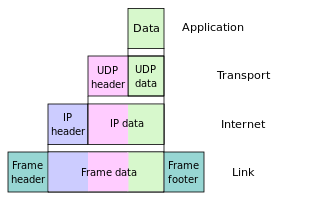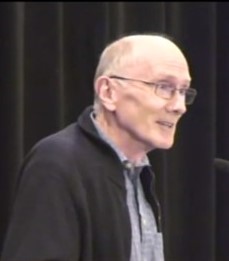Related Research Articles
The Internet protocol suite, commonly known as TCP/IP, is a framework for organizing the set of communication protocols used in the Internet and similar computer networks according to functional criteria. The foundational protocols in the suite are the Transmission Control Protocol (TCP), the User Datagram Protocol (UDP), and the Internet Protocol (IP). Early versions of this networking model were known as the Department of Defense (DoD) model because the research and development were funded by the United States Department of Defense through DARPA.

The Open Systems Interconnection (OSI) model is a reference model from the International Organization for Standardization (ISO) that "provides a common basis for the coordination of standards development for the purpose of systems interconnection." In the OSI reference model, the communications between systems are split into seven different abstraction layers: Physical, Data Link, Network, Transport, Session, Presentation, and Application.

Vinton Gray Cerf is an American Internet pioneer and is recognized as one of "the fathers of the Internet", sharing this title with TCP/IP co-developer Bob Kahn.
In the seven-layer OSI model of computer networking, the physical layer or layer 1 is the first and lowest layer: the layer most closely associated with the physical connection between devices. The physical layer provides an electrical, mechanical, and procedural interface to the transmission medium. The shapes and properties of the electrical connectors, the frequencies to transmit on, the line code to use and similar low-level parameters, are specified by the physical layer.

Paul V. Mockapetris is an American computer scientist and Internet pioneer, who invented the Internet Domain Name System (DNS).

David John Wheeler was a computer scientist and professor of computer science at the University of Cambridge.

David Lennox Mills was an American computer engineer and professor emeritus at the University of Delaware. He was an Internet pioneer who led the Gateway Algorithms and Data Structures (GADS) Task Force. He was known as the internet's "Father Time" for designing the Network Time Protocol, which is intended to synchronize all participating computers across different computer systems and networks to within a few milliseconds of Coordinated Universal Time.
ILLIAC was a series of supercomputers built at a variety of locations, some at the University of Illinois at Urbana–Champaign. In all, five computers were built in this series between 1951 and 1974. Some more modern projects also use the name.

Frank Thomson "Tom" Leighton is the CEO of Akamai Technologies, the company he co-founded with the late Daniel Lewin in 1998. As one of the world's preeminent authorities on algorithms for network applications and cybersecurity, Leighton discovered a solution to free up web congestion using applied mathematics and distributed computing.

Encapsulation is the computer-networking process of concatenating layer-specific headers or trailers with a service data unit for transmitting information over computer networks. Deencapsulation is the reverse computer-networking process for receiving information; it removes from the protocol data unit (PDU) a previously concatenated header or tailer that an underlying communications layer transmitted.

Yale Nance Patt is an American professor of electrical and computer engineering at The University of Texas at Austin. He holds the Ernest Cockrell, Jr. Centennial Chair in Engineering. In 1965, Patt introduced the WOS module, the first complex logic gate implemented on a single piece of silicon. He is a fellow of both the Institute of Electrical and Electronics Engineers and the Association for Computing Machinery, and in 2014 he was elected to the National Academy of Engineering.

The MISTIC, or Michigan State Integral Computer, was the first computer system at Michigan State University and was built by its students, faculty and staff in 1957. Powered by vacuum tubes, its design was based on ILLIAC, the supercomputer built at University of Illinois at Urbana–Champaign, a descendant of the IAS architecture developed by John von Neumann.

Brian Edward Carpenter is a British Internet engineer and a former chair of the Internet Engineering Task Force (IETF), the Internet Architecture Board (IAB), and the Internet Society.

Danny Cohen was an Israeli American computer scientist specializing in computer networking. He was involved in the ARPAnet project and helped develop various fundamental applications for the Internet. He was one of the key figures behind the separation of TCP and IP ; this allowed the later creation of UDP.
A communication protocol is a system of rules that allows two or more entities of a communications system to transmit information via any variation of a physical quantity. The protocol defines the rules, syntax, semantics, and synchronization of communication and possible error recovery methods. Protocols may be implemented by hardware, software, or a combination of both.
In computer networking, the link layer is the lowest layer in the Internet protocol suite, the networking architecture of the Internet. The link layer is the group of methods and communications protocols confined to the link that a host is physically connected to. The link is the physical and logical network component used to interconnect hosts or nodes in the network and a link protocol is a suite of methods and standards that operate only between adjacent network nodes of a network segment.
Chip Elliott is an American engineer, best known for his work in creating advanced computer networks.
The International Network Working Group (INWG) was a group of prominent computer science researchers in the 1970s who studied and developed standards and protocols for computer networking. Set up in 1972 as an informal group to consider the technical issues involved in connecting different networks, its goal was to develop international standard protocols for internetworking. INWG became a subcommittee of the International Federation for Information Processing (IFIP) two years later. Concepts developed by members of the group contributed to the original "Protocol for Packet Network Intercommunication" proposed by Vint Cerf and Bob Kahn in 1974 and the Transmission Control Protocol and Internet Protocol (TCP/IP) that emerged later.
The Protocol Wars were a long-running debate in computer science that occurred from the 1970s to the 1990s, when engineers, organizations and nations became polarized over the issue of which communication protocol would result in the best and most robust networks. This culminated in the Internet–OSI Standards War in the 1980s and early 1990s, which was ultimately "won" by the Internet protocol suite (TCP/IP) by the mid-1990s when it became the dominant protocol through rapid adoption of the Internet.
References
- ↑ Day, John D. (2008). Patterns in network architecture : a return to fundamentals. Pearson Education. ISBN 9780132252423 . Retrieved 2010-01-23– via Library of Congress Catalog Record.
- 1 2 3 Johnson, Johna Till (Mar 16, 2008). "Remember the Internet's past, or risk repeating it". IT World Canada. Archived from the original on 27 September 2011.
- 1 2 Crowcroft, Jon (2008). "Book review: Patterns in Network Architecture" (PDF). The Internet Protocol Journal. 11 (1): 37–38.
- 1 2 3 4 "John Day, ECE Adjunct Professor, Department Spotlight Seminar". Boston University, Department of Electrical & Computer Engineering. 2008. Retrieved 2010-01-23.
- 1 2 "Authors: John Day". InformIT. Pearson Education. Retrieved 2010-01-23.
- 1 2 3 4 5 "John Day curriculum vitae". A History of Computer Communications. Archived from the original on 8 October 2018. Retrieved August 8, 2013.
- ↑ Day, John D.; Zimmermann, Hubert (1983). "The OSI reference model". Proceedings of the IEEE . 71 (12): 1334–1340. doi:10.1109/proc.1983.12775. S2CID 30875675.
- 1 2 "Part-Time Faculty". Boston University Metropolitan College, Department of Computer Science. Archived from the original on 2010-01-18. Retrieved 2010-01-23.
- ↑ Day, John (2007). Patterns in Network Architecture: A Return to Fundamentals. Prentice Hall. ISBN 978-0-13-225242-3.
- ↑ Day, John D. (1995). "The search for the origins of the Chinese manuscript of Matteo Ricci's maps". Imago Mundi. 47: 94–117. doi:10.1080/03085699508592815. JSTOR 1151306.